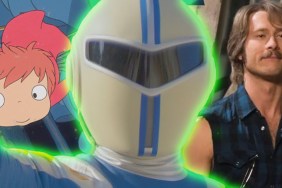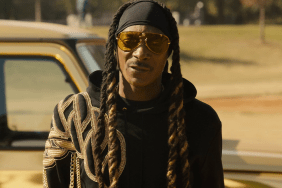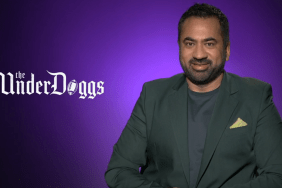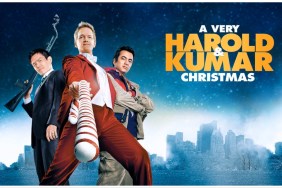Just over seven years ago, a little R-rated comedy called Harold & Kumar Go to White Castle opened in theaters, but didn’t really make that big a splash with its seventh place debut. For most, it was an introduction to John Cho and Kal Penn, two Asian-American actors who created very funny slacker characters that paid tribute to the stoner comedies of Cheech and Chong. It was the brainchild of screenwriters Jon Hurwitz and Hayden Schlossberg who took up the directing reigns on a sequel after the first movie became a huge cult hit on DVD and cable.
When that sequel Harold & Kumar Escape from Guantanamo Bay became an even bigger hit, a third movie was inevitable, so they’ve written and produced A Very Harold & Kumar 3D Christmas, which brings the potsmoking buddies played by John Cho and Kal Penn into present day (i.e. six years after the previous movie), but now Harold is married and has created a whole new life that doesn’t involve his slacker friend. With the holidays upon them, Harold’s wife Maria has her family come spend some time with them, but her tough father (Danny Trejo) doesn’t like Harold and certainly doesn’t trust him with the Christmas tree he’s been growing for eight years. When the long-absent Kumar shows up unexpectedly and destroys said tree, the former friends are back off on another crazy adventure.
At the same time as they were bringing back Harold and Kumar, Hurwitz and Schlossberg were commissioned by Universal to relaunch the “American Pie” franchise with next year’s American Reunion, which literally brings almost everyone back from the first movie.
ComingSoon.net got on the phone with the guys last week to talk about both movies and to be honest, we quickly lost track of which one was which so apologies in advance to John and Hayden if we misattributed the clever thing one of them said to the other.
ComingSoon.net: How did you guys actually get to make a third “Harold & Kumar” movie? The first movie wasn’t exactly Austin Powers.
Hayden Schlossberg: It’s been a little bit of a snowball effect. The first movie didn’t break box office records, but it was also a low-budget movie and so while it didn’t do huge business at the box office, it found its audience on DVD, much like a lot of the comedies that John and I liked growing up like “Office Space” or “Dazed and Confused.” It built over time, and I think the reason we got a sequel is that if you read the first draft of “Harold & Kumar Go to White Castle,” it ends with “To Be Continued…” there. We always intended for this to be a franchise, primarily because the characters are so fun to write for us, and also, there was this template that had already been set with the Cheech and Chong movies. It was a tough sell originally to have a studio to make a movie with a Korean-American and an Indian-American as leads, but we felt that if it felt like it could be a franchise that they would actually get into it. When the first “Harold & Kumar” movie was shot, we tested it in front of an audience, and it tested so well, they were like, “Okay, you have to write the sequel right now,” so we started writing the sequel and when the movie came out and didn’t do so great, we got a call the next day, “Stop writing the sequel.” It was another year or two before they saw how well it did on DVD and then we wrote the second “Harold & Kumar” and directed it and then it came out in theaters and did much better, almost three times the opening.
Hurwitz: And the Saturday phone call on that one was the opposite. It was, “Okay, are you guys ready to write a third one?” So yeah, we’re excited that Harold and Kumar have found their fanbase and people want to see more of them.
CS: With the last movie you got very political and then this one is a little bit more mainstream because it’s set during Christmas, which everyone can relate to. Was it very easy to come up with raunchy gags in that setting?
Hurwitz: You know what it is? What we intended with Harold and Kumar was to take these characters that are very real and relatable and put them into different kinds of movies. The first movie is sort of a coming of age road trip comedy, the second movie, what was going on in our headspace was post-9/11 paranoia and the weirdness it is to be a proud American living in a world where you’re not so proud of what’s going on and we thought that would be an interesting and fun movie that could be outrageous starring these two guys. When conceiving the third movie, we knew that we wanted the characters to be older, and where the first two movies played one after another in terms of the timeline, we knew that this was going to be present day and we liked the idea of doing a warm and fuzzy Christmas movie but giving it the Harold and Kumar treatment. When you have something that’s so pure and sweet like Christmas, there’s often comedy to be had playing with that in an R-rated way.
Schlossberg: And a lot of the Christmas movies that we loved, there seemed to be a little bit of an overlap between what they do and what a Harold and Kumar movies does, oddly enough, in the sense that there is a lot of out of this world stuff that happens in a Christmas movie, or some of them, like “The Santa Clause” and also, there’s this warmness and sense of friendship and family that in each Harold and Kumar movie, they sort of come together at the end, and it felt like a lot of what makes Christmas movies work could make a Harold and Kumar movie work. And also, to have that type of comedy in a Christmas environment just seemed very sacrilegious and outrageous and perfect.

CS: Was it tough convincing Kal and John to come back to the characters since they were both busy doing other things?
Hurwitz: You know, we have a lot of fun making these movies together. It’s been an interesting journey for all of us and we all know each other really well, we’re all good friends, and I think there’s just a desire, as long as we’re making Harold and Kumar movies, as long as we’re putting in the effort to make them good and entertaining and that we all like them, it’s something we’re all interested in doing. It’s really about a timing thing, finding the right time when we can all do it and this happened to be the time that worked out.
CS: I assume that both guys know the characters so well that they can improvise and remain in their characters. Is that the case?
Schlossberg: I think they’re comfortable with the characters so it definitely helps, but then there’s the flip-side of it, which is the more movies you do, sometimes actors almost know the characters too well in that they almost become caricatures and I think the thing we tried to do in the shooting of this movie is just really focus on the character stuff. Don’t make it too out there, because sometimes you’ll watch a movie and it’s just, “Okay, it’s getting ridiculous now” and we wanted to keep Harold and Kumar really relatable for an audience while also taking it to the next level. Look, they’re great actors, they’re really smart. It’s rare in a movie this silly to have a lot of really smart people like John Cho, Kal Penn and Neil Patrick Harris. If you listen to any of them talk, they’re really smart people, so they take it seriously and it was a good experience.
Hurwitz: Yeah, I think in terms of just sort of letting go and improving and being the guys, it’s an interesting thing because John and Kal are very much NOT like Harold and Kumar. Kal is definitely a lot more serious and a lot more of a Harold, and John is definitely a lot more of a Kumar in the everyday thing. I think they’ve really embraced these characters, and I think they know how to play in the Harold and Kumar sandbox in a certain way, but it’s really just the four of us work on these characters together, and we all learn from each other and try to make them the best that we can.
CS: You guys didn’t direct this, instead having Todd Strauss-Schulson direct it, so how did you find Todd and was it hard letting go and having someone else direct it?
Schlossberg: You know, it was tough ’cause we love these movies and we love these characters, but I think that we’ve learned is–and we didn’t direct the first “Harold & Kumar”–we directed the second one, but we’ve been very involved all the way through, and I think as long as we’re involved all the way through, that continuity is going to be there.
Hurwitz: This was a situation in which we actually were going to direct the third one. We were a few months away from shooting and then we got a call from Universal, approaching us about relaunching the “American Pie” franchise, writing and directing an “American Pie” reunion movie. That was a franchise in particular, that first “American Pie” was something that Hayden and I were huge fans of. In fact, we discovered John Cho through that first “American Pie,” and it gave us the confidence to write “Harold and Kumar Go to White Castle” in the first place. We wanted to do other things in addition to “Harold and Kumar.” We felt really good about the script that we had and the team that we had for “Harold and Kumar” and we felt that as long as we stayed really involved
a bunch of directors went up for it, and Todd had a really good take and really embraced the material and what Harold and Kumar was all about, so we felt confident that if we stayed involved and kept working with Todd and John and Kal, that the movie would turn out great and it gave us the opportunity to write and direct something else.
CS: Am I wrong to think that this has a much bigger budget than the other two movies? I have to assume the 3D itself must have cost as much as one of the other movies.
Hurwitz: Yeah, I think “Harold & Kumar 3” cost about as much as the first two “Harold and Kumars” combined.
Schlossberg: But both “Harold & Kumars” combined are significantly less than any other comedy that you see out there. It’s interesting. It’s still low budget, but we’ve tried in all these movies to make it feel as big as possible. When we had that first “Harold & Kumar Go to White Castle,” we wanted it to be as big an “American Pie” back then, and try to create an adventure movie. We didn’t have a lot of money to do it, only $9 million, but we milked it for all its worth, and the second movie, we didn’t get that much more because the first didn’t do that great. The first two were about $10 million each and this one was like $20 million. Most of the comedies you see out there are…
Hurwitz: 30, 40, 50, 60 million.
Schlossberg: Yeah, but this one feels bigger, I think, because of the 3D and also because the way we write these movies, they’re adventure stories, like “The Goonies,” so you see all this crazy sh*t happening and it just feels like an adventure, as opposed to some of the other youth comedies out there, which are set in high school or college.

CS: It’s interesting where “Harold & Kumar” fit into the world of R-rated comedy, because after “American Pie,” there was this wave of R-rated comedies which includes your first movie. Some of them didn’t do that great, so they stopped for a while, but now R-rated comedies seem the norm with six or seven over the summer where at one point, studios were afraid of doing movies that were too raunchy for younger audiences. How has that changed for you and is it a lot more freeing not having to worry about that stuff?
Hurwitz: Yeah, it’s really great. When Hayden and I became friends–we’re friends from high school–we bonded often over R-rated comedies and comedies that pushed the envelope. The Farelly Brothers were doing “Dumb & Dumber” and “Kingpin” when we were in high school and we just loved those movies and those were movies we looked forward to, and when we started writing in college, it was before “American Pie” came out and our big agenda at the time was “Let’s write an R-rated youth comedy where characters actually sounded like the young people we knew sounded,” and had the type of comedy that people like us liked, which was R-rated, so I remember we were writing a screenplay which was a youth comedy that was R-rated that felt real and when we saw the trailer for “American Pie” at the time. I remember seeing the trailer and we were like, “That movie is going to be a huge hit, obviously. It’s exactly what everyone wants to see right now.” That movie was a success, and the studios didn’t understand why it was a success. They didn’t realize that it has to be a good R-rated comedy, so there were a bunch of imitators that came out, and they were sh*tty movies, so they didn’t do well, not because they were R-rated, but because they were sh*tty. That was the frustrating part for us because we just moved to L.A., and we were just trying to do our brand of comedy, yet no one was making it, so that kind of inspired us to write “Harold & Kumar Go to White Castle,” because we knew that we could do our brand of comedy, it would be a lower budget thing, it would be original. No one else in town would be writing it, and we were thrilled when we wrote that movie, tested the movie, and the audience loved it. it was the forefront of a wave of R-rated comedies and we’re in a playground now. A lot of talented people are making R-rated comedies, so we have fun movies we get to watch, and we get to continue making the kind of movies that we like.
CS: I have to say that the little girl in this movie is a scene stealer. I can’t imagine as you were writing this that you thought it would be easy to find a little girl actress who could do all that stuff and find parents who’d let them. How did you find this little girl and make things work out?
Schlossberg: The crazy thing about writing these Harold and Kumar movies is we do write them. We write it in a room and then it’s like, “Okay, now somebody actually has to find the girl.” Or in the first movie, we wrote all this stuff with Neil Patrick Harris that somebody’s going to have to find Neil Patrick Harris and ask him if he’s going to want to do this stuff. That’s one of the most fun things about it is coming up with all this crazy f*cked up surreal sh*t on our sofas at home and then actually seeing a major studio have to spend money and time and resources to try and find it. In this situation, I think they found a group of triplets, just the cutest girls of all time. The thing is it looks inappropriate to the audience but when you’re shooting the movie, it’s not like we’re actually putting cocaine in a baby’s face.
Hurwitz: The other thing is we’ve seen the movie with an audience and every time that baby’s getting high on screen accidentally, the crowd goes nuts, and I think when you think about finding the parents who are going to allow their kids to do it, it’s clearly something a large number of people find funny. When you’re searching for people, there are going to be people who know that this is going to be really funny when their kid is doing it, and then there are going to be people who probably don’t get it. It takes a certain kind of parent–my kind of parent–who is going to recognize that there’s a comedic arc to what is going on there and that their child is part of something that’s really funny.
CS: I do want to talk about Neil Patrick Harris because for this one, he really seems to have been game for anything in making fun of his own image. Do you actually work with Neil on the material and throw things by him or just write the script and he’s okay with it?
Hurwitz: By now, by the third movie, we know each other, we’re friends. We’ve obviously helped each other out. The “Harold & Kumar” movies helped him and he’s a huge part of these movies, so we know him and we’re able to call him up and say, “Listen, this is the idea that we’re thinking of.” He’s obviously been cool in the past doing all sorts of crazy sh*t involving his real life personal so we’re not that afraid to think of wild, outrageous things for him. The big difference in this go-round is with the first movie, most people just saw him as Doogie Howser so he was playing with that image of people, this clean-cut genius doctor and playing with that. In between the first and second movie, he got “How I Met Your Mother” and it became public knowledge that he was gay, and so when we were writing the second movie, the studio was telling us “Well, you’ll have to do something with the gay thing,” but for us, the movie was taking place the day after “Harold & Kumar Go to White Castle” so it wouldn’t make sense. He hadn’t come out yet and “How I Met Your Mother” didn’t exist. This go-round we were like, “Okay, this is taking place present day and Neil Patrick Harris, as everybody knows, isn’t Doogie Howser. He’s the guy on ‘How I Met Your Mother’ and people are aware of (him).
Schlossberg: He hosts awards shows and “Regis and Kelly” and stuff like that, and we figured, there’s a lot of fun to be had with the Neil that’s famous today. So we came up with these ideas. We took Neil to dinner and got him liquored up on sake and he loved it, and from there we write scenes, we send him the scenes, he calls him up and tells us his thoughts, we collaborate on it, and take it from there. But it was really fun this time to incorporate his real life and incorporate his partner David in the movie, and play with the public perception of him.

CS: So you guys are now finishing up “American Reunion,” and I gotta say, I was one of the people who was pretty cynical about doing another movie, and I gotta say that teaser alone kind of sold me on it. How has it been playing in that playground with your own style of humor? Do you have to write more towards those movies than how you normally might?
Schlossberg: Yeah, we did. We’re huge fans of that original “American Pie” and when they approached us about writing and directing that movie, it was like fan fiction for us. We didn’t want to turn it into something that’s different, because we love that original “American Pie.” It was important to us that the reunion movie, that an audience who loved that first film was going to be able to feel the same way that they did about this movie that they did about the original, which is, “This is me and my friends on the big screen.” So in terms of “American Reunion,” we really just took the characters that existed, that everybody loves, whether it’s Jim or Stifler or Oz, and figured out, “Okay, they’re no longer that kid in high school or just post-college in the other sequels, they’re now people in their early 30s and what are the things that would be happening in Jim’s life at this age? Or Oz’s life at this age? Or Stifler’s life at this age?” And go with that place of reality, because “American Pie’s” tone is definitely a lot more grounded and more relatable than say Harold and Kumar is from top to bottom, whereas the Harold and Kumar characters, those two guys are relatable, but their characters go through a series of surreal and weird situations. “American Reunion” should feel like it’s an “American Pie” movie and go for the big laughs in a way that’s a little bit more grounded.
CS: Any idea what you might do when that’s done? Do you expect to get another call on Saturday morning saying, “Can you guys write another Harold and Kumar movie?” and is that something you might want to do or do you want to move onto other things?
Hurwitz: We definitely want to do different things, but there’s nothing that would make us happier. I think the dream for us would be to do all sorts of different types of movies and have a successful career, but still come back to the well and do these “Harold and Kumar” movies, because for us, they’re fun, they’re easy to write and unlike any other comedy out there, there’s really no rules in them, so it’s a different type of comedy experience.
CS: What about the other spec scripts that you sold like “Grandma vs. Grandma” and “Til Beth Do Us Part”? Are those still being developed and you’re still working on them?
Schlossberg: Those are projects that we love and they’ve just sort of been on the backburner right now. They’re projects we’re definitely hoping to see on the big screen at some point in the future, but we have a lot of other ideas as well, so we’re just sort of generating as much material as possible and working hard to get the movies made, and we are as curious as you are about what’s next. We definitely have ideas and we’ll see.
A Very Harold & Kumar 3D Christmas opens nationwide on Friday, November 4.









